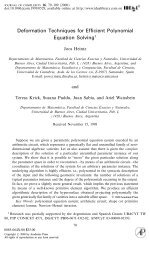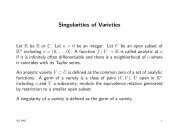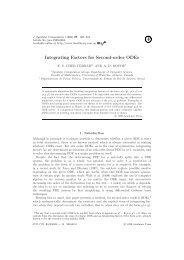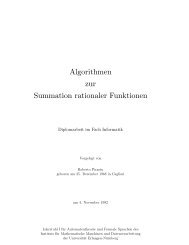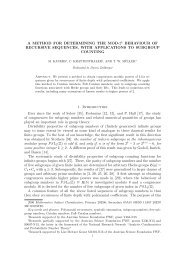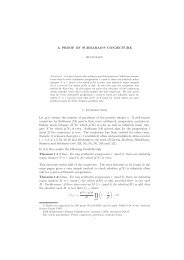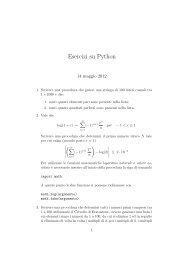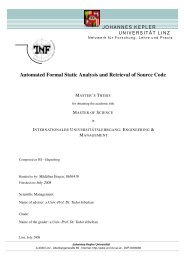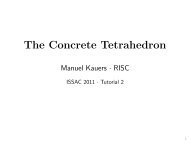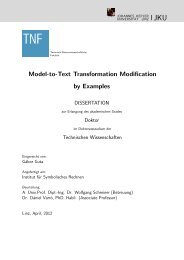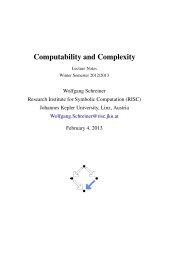Chapter 7 Local properties of plane algebraic curves - RISC
Chapter 7 Local properties of plane algebraic curves - RISC
Chapter 7 Local properties of plane algebraic curves - RISC
You also want an ePaper? Increase the reach of your titles
YUMPU automatically turns print PDFs into web optimized ePapers that Google loves.
Every point (a, b) on C corresponds to a point on (a : b : 1) on C ∗ , and every additional<br />
point on C ∗ is a point at infinity. In other words, the first two coordinates <strong>of</strong> the<br />
additional points are the nontrivial solutions <strong>of</strong> f d (x, y). Thus, the curve C ∗ has only<br />
finitely many points at infinity. Of course, a projective curve, not associated to an<br />
affine curve, could have z = 0 as a component and therefore have infinitely many<br />
points at infinity.<br />
On the other hand, associated to every projective curve there are infinitely many<br />
affine <strong>curves</strong>. We may take any line in P 2 (K) as the line at infinity, by a linear change<br />
<strong>of</strong> coordinates move it to z = 0, and then dehomogenize. But in practice we mostly<br />
use dehomogenizations provided by taking the axes as lines at infinity. More precisely,<br />
if C is the projective curve defined by the form F(x, y, z), we denote by C ∗,z the affine<br />
<strong>plane</strong> curve defined by F(x, y, 1). Similarly, we consider C ∗,y , and C ∗,x .<br />
So, any point P on a projective curve C corresponds to a point on a suitable affine<br />
version <strong>of</strong> C. The notions <strong>of</strong> multiplicity <strong>of</strong> a point and tangents at a point are local<br />
<strong>properties</strong>. So for determining the multiplicity <strong>of</strong> P at C and the tangents to C at<br />
P we choose a suitable affine <strong>plane</strong> (by dehomogenizing w.r.t to one <strong>of</strong> the projective<br />
variables) containing P, determine the multiplicity and tangents there, and afterwards<br />
homogenize the tangents to move them back to the projective <strong>plane</strong>. This process does<br />
not depend on the particular dehomogenizing variable (compare, for instance, [Ful69]<br />
Chap. 5).<br />
Theorem 7.1.3. P ∈ P 2 (K) is a singularity <strong>of</strong> the projective <strong>plane</strong> curve C defined<br />
by the homogeneous polynomial F(x, y, z) if and only if ∂F ∂F ∂F<br />
(P) = (P) = (P) = 0.<br />
∂x ∂y ∂z<br />
Pro<strong>of</strong>. Let d = deg(F). We may assume w.l.o.g. that P is not on the line at infinity<br />
z = 0, i.e. P = (a : b : 1). Let C ∗,z be the affine curve defined by f(x, y) = F(x, y, 1)<br />
and let P ∗ = (a, b) be the image <strong>of</strong> P in this affine version <strong>of</strong> the <strong>plane</strong>.<br />
P is a singular point <strong>of</strong> C if and only if P ∗ is a singular point <strong>of</strong> C ∗,z , i.e. if and only<br />
if<br />
f(P ∗ ) = ∂f<br />
∂x (P ∗) = ∂f<br />
∂y (P ∗) = 0.<br />
But<br />
∂f<br />
∂x (P ∗) = ∂F<br />
∂x (P),<br />
∂f<br />
∂y (P ∗) = ∂F<br />
∂y (P).<br />
Furthermore, by Euler’s Formula for homogeneous polynomials 1 we have<br />
The theorem now follows at once.<br />
x · ∂F ∂F ∂F<br />
(P) + y · (P) + z · (P) = d · F(P).<br />
∂x ∂y ∂z<br />
1 Euler’s formula for homogeneous polynomials F(x 1 , x 2 , x 3 ):<br />
deg(F)<br />
∑ 3<br />
i=1 x i · ∂F<br />
∂x i<br />
= n · F, where n =<br />
91



